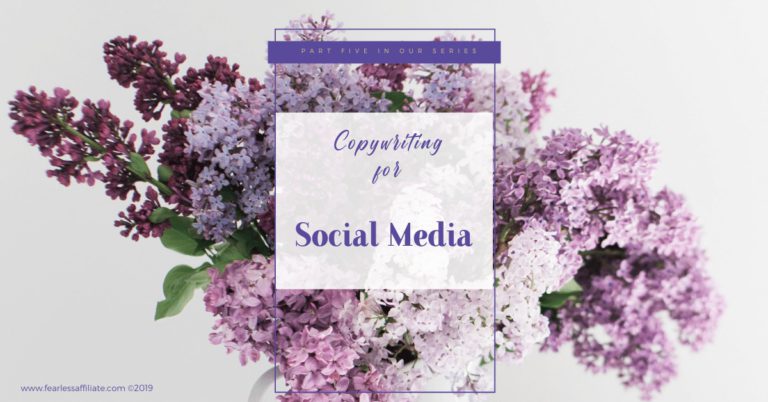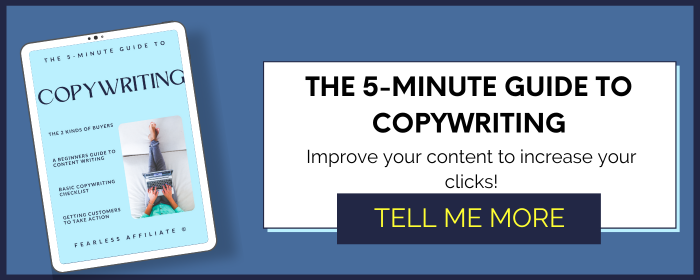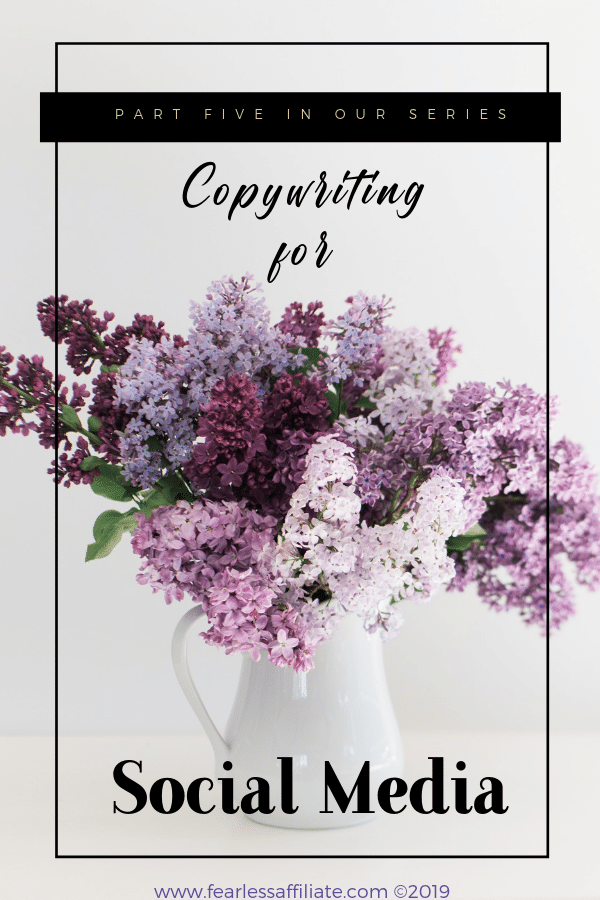Copywriting for social media is just another form of copywriting, but there are some tweaks you may want to apply. And while Your immediate goal may not be to get fans and followers to purchase something, you do hope they will spend money with your brand eventually.
That means being strategic with your social media updates and recognizing them as an important relationship-building tool. Look for the other posts in the series by following the provided links. Related Post: Copywriting for Beginners: The Basics
Hello and welcome to Fearless Affiliate…education for new bloggers and online entrepreneurs.
My name is Irma and I help new bloggers to learn the ropes. There is a lot to take in that first year of blogging, from choosing a niche to changing your mindset to that of a successful entrepreneur.
I like to focus on practical information and positive thinking, so if that sounds good to you please sign up for my weekly newsletter of tips for bloggers. Sign up for my FREE 5-Minute Guide to Copywriting and start improving your website copy to increase engagement and clicks.
This post may contain affiliate links. If you click a link and make a purchase, I may receive a commission at no extra cost to you. Full disclosure is here.
Copywriting for social media: Tweaks
1. Share Your Journey
When someone follows you on social media, it’s like you’ve been invited into their home. You wouldn’t go to an acquaintance’s apartment, kick off your shoes, and try to sell them your latest product.
No, you’d spend time getting to know them. Paying attention to your shared interests and talking about those first.
On social media, this can take the form of sharing posts that you know your community would enjoy. If you’re part of the camping community, then post a photo of your latest adventures in the outdoors. If you’re part of the food community, share a video of yourself creating a new recipe over the weekend.
Also, it is a good idea to maintain your brand voice in your ad copy. As well, clearly incorporate the 5 W’s by answering potential questions your readers may have.
2. Offer Value
It’s OK to make an offer to your social media followers; but, do it in a way that adds value to their lives and makes them want what you’re offering. For example many bloggers create Facebook Live videos where they talk about their latest blogging products and then they offer a discount coupon to potential purchasers.
Facebook videos allow you to share valuable tips, visually, to your followers, as well as other helpful information. This works well for any review product that you may be promoting.
Related Post: Copywriting for Landing Pages
Another tips is to target your audience’s FOMO: fear of missing out. Let them know that whatever you are offering won’t be around forever. Countdown timers and limited time offers fit this bill nicely.
3. Ask Questions
Don’t just talk to your followers on social media. Take time to engage with them by asking questions and responding to comments. Keep your questions related to your niche and don’t go for simple yes or no responses.
Instead, ask complex questions. Most complex questions start with “Why…?” or “How…?” For example, don’t ask “Are you going to set your goals for the year?” That won’t invite conversational responses.
Instead, ask your followers, “How will you achieve your goals for this year?” This question can be the springboard for deep discussions about types of goal setting programs and products as well as accessory products like planners.
Apply what you’re learning about copywriting for social media posts. You’ll be amazed to see how useful copywriting hacks can be, especially on social platforms like Facebook and Twitter.
Related Post: AIDA: The Copywriting Template for Bloggers

4. Use Different copy for different social media channels
The best advice that I can give about using social media for your blog or website is to choose one channel at a time. Learn all that you can about this channel and how to bring traffic to your website with it before you move on to the next channel. Trust me, it is so much easier. And you are not spread so thin trying to engage masses of people in different ways.
Be sure to use the 4 C’s of copywriting for social media posts: clear, concise, compelling and credible. Start with ‘clear’ and then move on to the others. Be sure to tell a story and then use cliffhangers to encourage readers to click through.
Make sure that you are formatting correctly for each channel. You do not want a Twitter or Instagram-style “@…” landing on Facebook, where it makes no sense.
You can get awesome plugins for WordPress.org blogs that will allow you to write copy for each channel you are sending to. My favorite is Social Warfare, but there are others that do a similar job.
Related Post: Social Warfare (product review post)
Facebook has something like 30 billion pieces of content shared on their platform…per month! That is some competition, but remember that not all of the 30 billion is competing with you and your niche. Here are some tips to help you:
- You can max out at 206 characters with a Facebook feed post, but don’t. Posts with 80 characters or less get better engagement. Be laser focused with your copy to get the most bang for your ad-spend buck. And be sure to use great images, because you can see 2.3x more engagement.
- Write copy that encourages conversation and community building.
- Facebook is best used to promote blog posts, videos and reports. People on Facebook want interesting content, so use attention-grabbing text and ask questions.
- Facebook is also the best place to promote to the 65+ age group, so PPC is great here.
Instagram started off as a platform to share photos and videos but has turned into a powerhouse for influencers. It is highly visual, and not so great for driving blog traffic.
- Instagram ranks posts based on: Interest, Timeliness, and Relationship. This is designed to give people more of the content they want from the people they care about the most.
- Use powerful copy to emphasize your photos. Keep captions brief.
- If you sell products, shoppable Instagram stories is for you. I see tons of pins titled “shop my Instagram” now in the Pinterest platform, which makes it easy for people to buy products that they see on the app. Just look for the shopping bag icon to see more details.
- IGTV (2018) allows long-form video content. Instagram stories allowed 15-second stories, but IGTV videos can be up to an hour long. And they stay around forever, so you can get engagement of potentially forever. This is great if you like to do “how-to” videos in your niche.
- If you like using hashtags, then Instagram is the place to be. It is recommended to use no more than 7 (the sweet spot). More than 8 may be perceived as spam.
- Instagram also has its share of algorithm updates, so you need to keep up them to maintain your followers.
Twitter is a great place to hone your copywriting skills, as you only get 140 280 characters. This does not include your images, polls, or other quoted tweets. However, the extra characters have not had much impact on the average tweet size, which is 33 characters.
- The ideal length of a tweet appears to be 120 to 130 characters, as this give the best click-through rate.
- No need to go hashtag-crazy, but be sure to summarize your tweet with an appropriate hashtag or two (at most). All tweets with hashtags get double engagement. Here is some helpful information for those new to using Twitter for their blogs.
- Connect with your audience on the emotion behind the post. Read this post on emotional headlines from CoSchedule to find the right power words for your copy.
- Once you have somewhat mastered Twitter, use it to drive traffic to your next social media channel, like Facebook. Send your followers over to Facebook for live streams.
I am not a pro with LinkedIn, but I will give you tips from others who are! And the best tip is that LinkedIn is a great place to re-post blog content. It is a network for ‘professionals’, but is used for sharing industry articles and blogging content.
- Now that LinkedIn has an influencer program, you can share blog content to a much larger audience.
- Unlike other social media, which has limited content sharing, you can share full text and images with author/source credit. You get 100 characters for the title and 40,000 for the body text!
- 29% of online adults use LinkedIn, so that is a lot of reach.
- Related Post: Copywriting for Online Ads
- Related Post: Using Analytics for Copywriting
Conclusion
I hope that you have enjoyed this post and have learned some tips to use in your social media copy. This list is not comprehensive. Instead, I opted to share about the big four social media channels. Pick one of them and learn all that you can about bringing traffic to it. This will help you understand your audience better and it will make sharing easier.
Speaking of sharing, please share this post with anyone who may benefit from it. And don’t forget to click the image below to sign up for my FREE my 5-Minute Guide to Copywriting.
Happy blogging, and follow me on Pinterest!
-Irma 🙂



This article will really help me with social site involvement, I keep on shying away every time it gets close.
Best advice you give is take one at a time and master it.
On Pinterest I have many followers for quite awhile, from before WA, but it is mostly known for my shared recipe posts, shall I try to get some of those followers involved, I have started a business board now too.
What will your advice be Irma?
Facebook will be the best option for my type of blog, but not many followers there.
Thanks a million!
Stella
Hello Stella and thank you for visiting us today,
For Pinterest, if your previous personal account is the same niche as your website, then make that account a business account. The built in followers etc will help your business account.
If they are not the same niche, then move forward with your new business account and start following people in the same niche. Save your old personal account for your non-business pins.
To start your new account you will want to follow some “influencers” in your niche (ie. the big players). Type your niche into the search bar and hit enter. When the results pop up, use the down arrow in the search bar and choose “people”. Following other bloggers that are big players in your niche will ensure that you have some really good popular pins in your feed to repin. And if their pins go viral, and you have repinned it, you will ride that wave with a popular pin.
Also, you can choose “boards” from the same drop down menu, and start looking for ideas on how to set up your boards. You should start off with 10 to 15 boards related to your niche. Then search those board names in Pinterest to find pins to add to your new boards. You can always change the name of your boards later. And add more boards as necessary.
Then try to settle on one or two pin design layouts and keep making new pins, pinning them often to raise your number of monthly viewers. This is a vanity metric, but when you have a new business account, you need all the help you can get to get your own pins seen.
Pinterest rewards consistency of pinning, so if you can pin or repin at least 10 pins per day, you will rise.
I found that it took me a couple of weeks to set up my boards and find some quality people to follow. Pinterest is still my favorite way to get traffic after SEO.
Facebook is something I have avoided learning about, only because I was so focused on using Pinterest. I have some ebooks on how to use it and I just have to sit down and do some reading. I will publish a post with my findings soon…
Cheers,
-Irma 🙂
Great post. Thank you for all the useful information. I am just learning how to use social media to promote my blog. I find I spend a lot of time making images for my posts, as each platform has different image size requirements. I am trying to figure out which platform is driving the most readers to my blog, so I can focus on just that one, but I am not sure yet.
Thank you for some great tips on Facebook. I will definitely be using the one about asking questions to see if I can get more engagement from my followers. I will check back and let you know if it worked.
Thanks again!
Way to go Ashley and thank you for visiting us today,
My next post will have some helpful information on using analytics with your copywriting, so stay tuned for that. I wish you the best of luck 🙂
Cheers,
-Irma 🙂
I know most people want that individual experience, to make them feel special haha. This is great advice, I’m still trying to build my audience before I can even start looking at analytics. I’m a big fan of Pinterest right now, I need to get into Twitter more but doesn’t tweets only have a lifespan of like 30 minutes?
Hi Nate and welcome back!
Yes, tweets have a short life span. Facebook feed posts are about twice as long. Personally I get a lot of my traffic with Pinterest, which is where I focus my time even though it is not technically social media. And you still need to apply copywriting rules to the text on pins. My next project will be promoted pins, which are the paid ads on Pinterest.
Cheers,
-Irma 🙂
WOW! I must say I have come to the end of the road in my search for a decent social media post technics. I have been in this business for a while now but when it comes to social media, it has been a big challenge to me until i found your post. Thank you very much for such a very informative post. Great post I must say.
This is exactly what i have been looking for.
Thank you.
You are welcome Yenge Eric and I wish you the best of luck with your social media copywriting!
Cheers,
-Irma 🙂
Great post. I am not really a fan of using social media in regards to my blogging business. Simply put – it is not my thing. I am really not on social media much.
The ones that do catch my attention Pinterest, Reddit and YouTube simply because they are more passive in terms of traffic generation.
Twitter is 280 characters – they doubled it a few years ago.
Hello Derek and thank you for visiting us today,
You are right and I have updated my post. I have only ever stuck to the 140 characters because it is simpler and I think “less is more”. I do admit that I have not been using Twitter to its fullest. I prefer to focus on Pinterest for traffic.
Cheers,
-Irma 🙂
I like how you laid out specific directions for each social media platform. That is important. So many blogs I’ve read are so vaguely written that I have to search around the internet just to track with what the blog is saying. You have it all in one place.
Good job!
Hello David and thank you for visiting us today,
I have also noticed many new blogs have links to every possible social media platform. I know that I had to ditch the ones that I did not have time to learn about, or that did not work with my brand. Using social media to gain traffic and conversions is so crucial that you really have to focus on one or two to get a decent audience.
Cheers,
-Irma 🙂
Hi Irma
Thank you so much for this article, social media is the net thing to master and I seem to stumble on your site at just the right time. Thank you for a very detailed outline on how social media works and how to use it.
Best wishes
Hello Tim and thank you for visiting us today,
I wish you the best of luck with your online ventures 🙂
Cheers,
-Irma 🙂